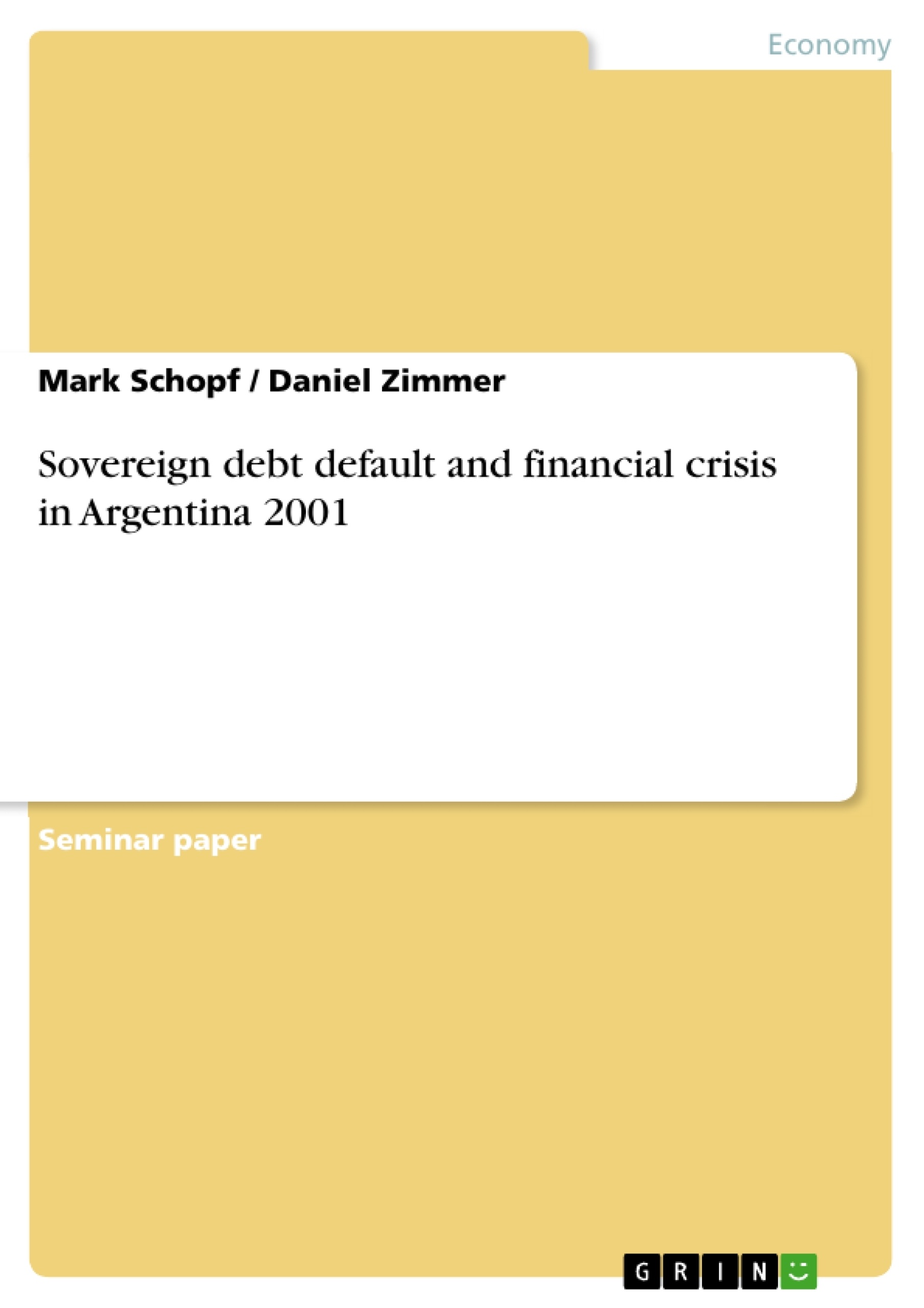In order to understand the causes of the Argentine economic crisis one has at least to know something about the Plan Cavallo which was established in Argentina in the year 1991. At the end of the 1980s the country suffered from hyperinflation with prices increasing above 3000 percent per year. This currency crisis was accompanied by an accumulated decrease of GDP between 1988 and 1990 of about 10 percent. After several failed attempts to stop this development the newly appointed minister of economic affairs, Cavallo, established two laws which improved the situation. First, the Ley De Convertibilidad came into effect that fixed the exchange rate between the Argentine currency and the U.S. dollar. Second, the Ley de Carta Orgánica del Banco Central emerged which obligated the central bank not to finance budget deficits anymore. These two laws became generally known as the Plan Cavallo. The incentive was to reestablish confidence in the sense that Argentina would not inflate away its domestic debt anymore.
The Plan Cavallo operated very well until the crisis with respect to two macroeconomic quantities: On the one hand, the exchange rate was kept constant at a one-to-one level towards the U.S. dollar. On the other hand, the inflation rate declined from still 84 percent in the year 1991 to 1.6 percent in the year 1995. Since then it was kept between -1.8 and 0.7 percent until the year 2000. Furthermore, a lot of privatization took place in the first half of the 1990s and the whole decade was characterized by an increase of foreign direct investment above 500 percent. Altogether, Argentina was a “star” country in the perspective of international organizations.
Nonetheless, there were some erroneous trends. First, there was a real revaluation of the Argentine peso with respect to the U.S. dollar: While the nominal exchange rate stayed constant, prices in Argentina rose by 153 percent, prices in the United States only by 30 percent from 1991 to 2000. In other words, assuming that prices of export and import goods increased by the same relation, exports from Argentina to the United States doubled in prices while imports to Argentina from the United States halved in prices during this period. Second, the debt ratio increased from 38.8 percent in the year 1991 to 50.8 percent in the year 2000 despite the fact that GDP grew by 4.2 percent on average during this period. In other words, the Argentine government pursued a pro-cyclical policy in the considered period.
Inhaltsverzeichnis (Table of Contents)
- Introduction
- Definitions linked to a sovereign debt default
- Reasons for a sovereign debt default
- External debt default versus domestic debt default
- Banking crises, currency crashes, inflation crises
- Mechanisms of the sovereign debt default in Argentina 2001
- Preamble of the crisis
- Causes for the crisis
- The crisis itself
- Aftermath of the crisis
- Conclusion
Zielsetzung und Themenschwerpunkte (Objectives and Key Themes)
This paper examines the concept of sovereign debt defaults, specifically focusing on the case of Argentina in 2001. The paper analyzes the evolution of the relationship between banks and states in times of financial crisis, particularly highlighting the role of state intervention in stabilizing financial markets and preventing bank failures. The paper delves into the reasons behind sovereign debt defaults, emphasizing the distinction between unwillingness and inability to repay. It also explores the interrelation between sovereign debt defaults and other economic crises, including banking crises, currency crashes, and inflation crises.
- Sovereign debt default mechanisms and causes
- The role of state intervention in financial crises
- The relationship between banks and states in times of crisis
- Distinguishing between unwillingness and inability to repay debt
- The interrelationship between sovereign debt defaults and other economic crises
Zusammenfassung der Kapitel (Chapter Summaries)
- Introduction: The introduction provides a historical overview of the relationship between banks and states in times of economic turmoil, highlighting the evolution of state roles in financial systems. It introduces the concept of sovereign debt defaults and sets the stage for the analysis of the Argentine crisis of 2001.
- Definitions linked to a sovereign debt default: This chapter provides definitions and explanations related to sovereign debt defaults, including the distinction between unwillingness and inability to repay. It explores different factors influencing sovereign debt defaults, such as the country's economic situation, its debt levels, and its ability to access international capital markets.
- Mechanisms of the sovereign debt default in Argentina 2001: This chapter delves into the specific case of Argentina in 2001. It analyzes the pre-crisis context, the factors leading to the crisis, the unfolding of the crisis, and the aftermath of the default, examining the economic and social consequences of the crisis.
Schlüsselwörter (Keywords)
The primary keywords and focus topics of this paper include sovereign debt default, Argentina, financial crisis, state intervention, banking crisis, currency crash, inflation crisis, unwillingness to repay, inability to repay, external debt, domestic debt, international capital markets, economic instability, and the relationship between banks and states.
- Quote paper
- Bachelor of Science Mark Schopf (Author), Bachelor of Science Daniel Zimmer (Author), 2010, Sovereign debt default and financial crisis in Argentina 2001, Munich, GRIN Verlag, https://www.grin.com/document/161390



